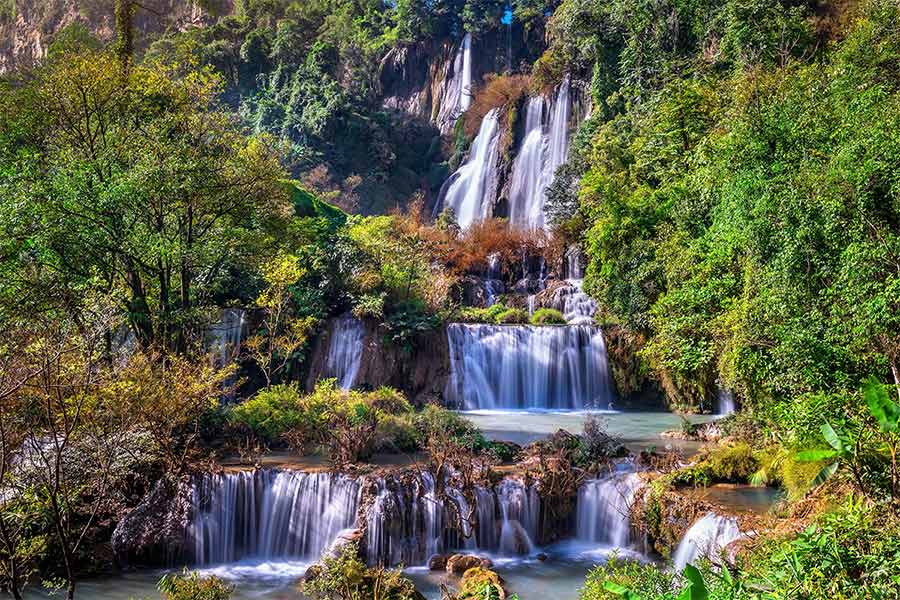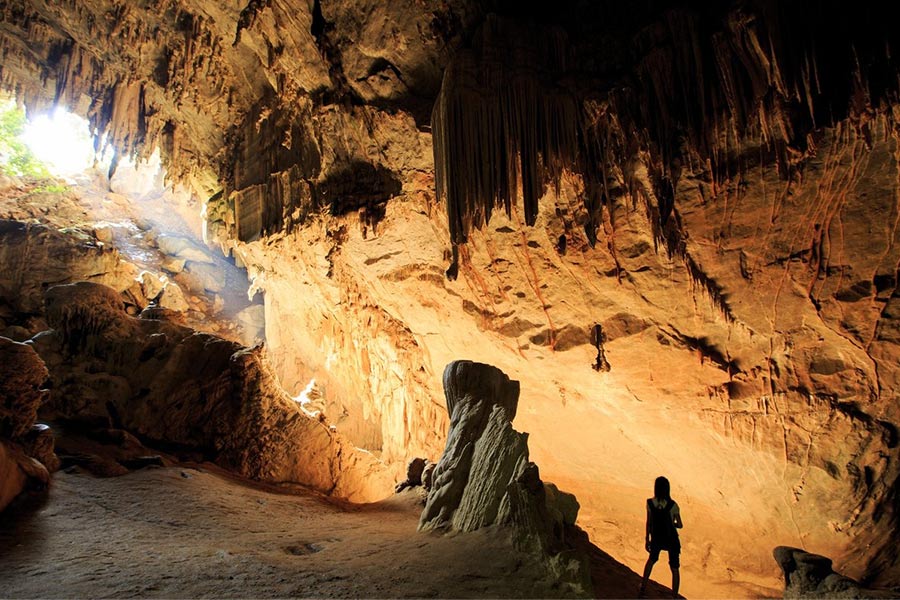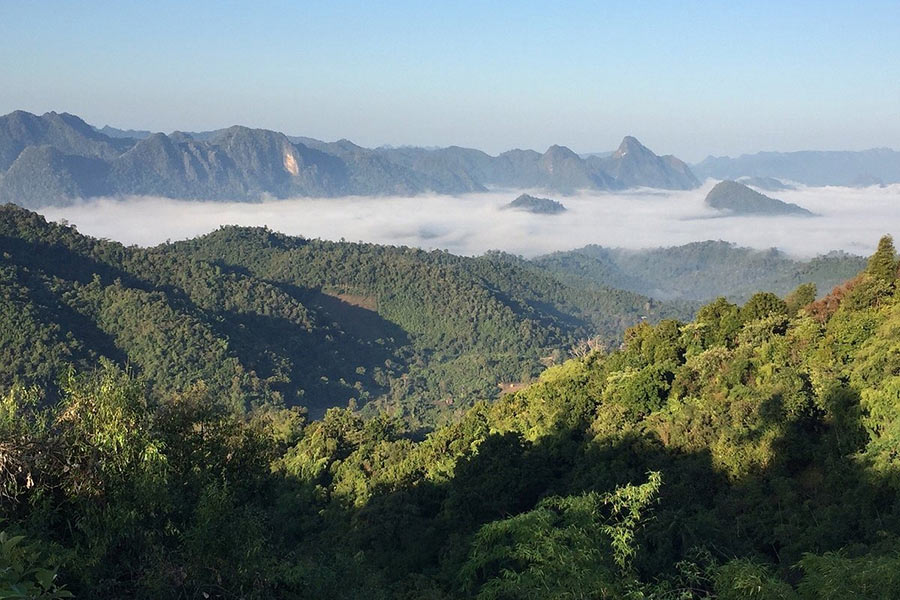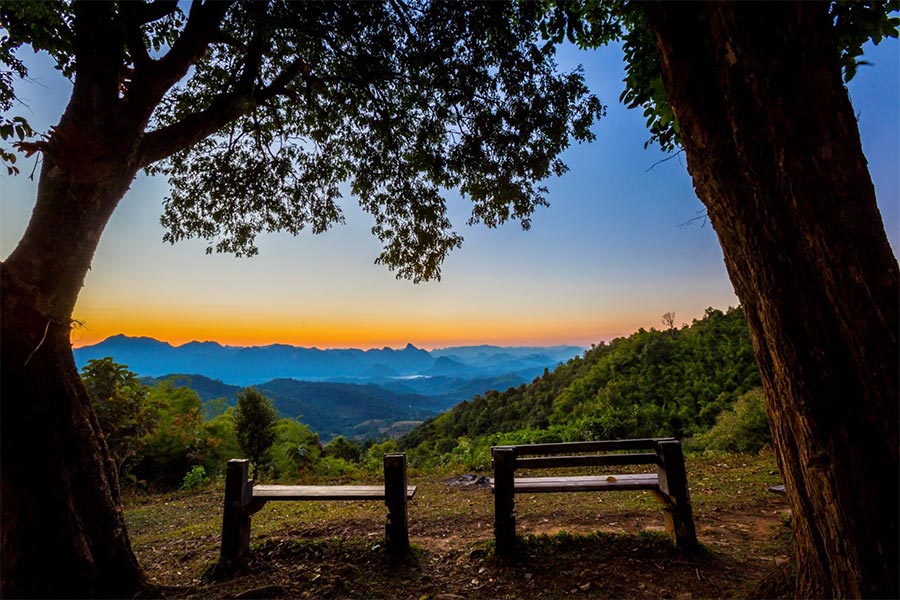Tak

Located in the northwestern part of Thailand, Tak Province is a picturesque destination with a rich cultural heritage and stunning natural landscapes. It is bordered by Myanmar to the west and north, and is characterized by its rugged mountains, verdant forests, and winding rivers. Let's get to know this province with Asia King Travel!

Thi Lo Su Waterfall is a popular destination in the province
One of the highlights of Tak is its diverse ethnic communities, including the Karen, Hmong, and Lisu people, each with their own unique traditions and way of life. Travelers have the opportunity to immerse themselves in local culture by visiting hill tribe villages, participating in traditional festivals, and sampling authentic regional cuisine.
Nature enthusiasts will also find plenty to explore in Tak. The province is home to several national parks, including Umphang Wildlife Sanctuary and Mae Moei National Park, which offer opportunities for trekking, birdwatching, and wildlife spotting. The area is also known for its waterfalls, such as Thi Lo Su, the largest waterfall in Thailand, which cascades over limestone cliffs in a breathtaking display of natural beauty. For history buffs, the province boasts a number of historical sites and ancient ruins, including Wat Phra Borommathat, a revered Buddhist temple dating back to the 16th century.

Mae Usu Cave captures visitors's hearts with its magnificant sight
Whether you're seeking adventure in the great outdoors, cultural immersion, or a glimpse into Thailand's rich history, Tak Province offers something for every traveler. With its scenic beauty, cultural diversity, and wealth of attractions, it's no wonder that Tak is becoming an increasingly popular destination for visitors to northern Thailand.
You may like: Thailand Classic Highlights Tours
The region has a rich and diverse history that spans centuries, with evidence of human settlement dating back to ancient times. The area has been inhabited by various ethnic groups, including the Karen, Hmong, Akha, and Lua people. One of the earliest recorded kingdoms in the area was the Kingdom of Lavo, which flourished from the 7th to the 11th centuries. In the 13th century, the area came under the control of the Sukhothai Kingdom, one of the first independent Thai kingdoms. Tak served as a strategic outpost for Sukhothai, guarding its northern borders against neighboring kingdoms and facilitating trade along the important trade routes that passed through the region.

Wat Phra Borommathat, built in the 11th century, is one of many reminders of the province's history
During the Ayutthaya period (14th to 18th centuries), the province continued to play a significant role in Thai history. This area was a key battleground during the Burmese-Siamese wars, with both kingdoms vying for control of the region. The city of Tak, then known as Mueang Rahang, was a major stronghold for the Siamese forces, resisting multiple Burmese invasions. In the 19th century, Tak Province became part of the expanding Rattanakosin Kingdom, also known as Siam or modern-day Thailand. The province experienced periods of prosperity and growth, as well as challenges such as border conflicts and unrest among ethnic minority groups.
Throughout its history, Tak Province has been shaped by its geographical location at the crossroads of different civilizations and cultures. Today, it remains a melting pot of ethnic diversity, with influences from Mon, Khmer, Burmese, and Thai cultures evident in its architecture, cuisine, and traditions.
You may like: Thailand Family Tours
Tak General weather
Tak Province experiences a tropical savanna climate characterized by distinct wet and dry seasons. The weather is generally hot and humid throughout the year, with temperatures varying depending on the season.

The province has a tropical climate with distinct seasons
The dry season typically spans from November to April, with December to February being the coolest months. During this time, temperatures are relatively pleasant, ranging from around 20 to 30 degrees Celsius (68 to 86 degrees Fahrenheit). The skies are mostly clear and rainfall is minimal.
The wet season in Tak Province usually occurs from May to October, with June to September being the wettest months. During this period, the region experiences heavy rainfall, particularly in the form of afternoon thunderstorms and downpours. Humidity levels are high, and temperatures can soar, with daytime highs often reaching into the mid to upper 30s degrees Celsius (90s to 100s degrees Fahrenheit). Despite the rain, the lush vegetation thrives during this time, creating vibrant green landscapes and swollen rivers and waterfalls.
Best time to visit Tak
Generally, the peak tourist season coincides with the dry, cooler months from November to February, making this period an ideal time to explore the region. During these months, temperatures are more moderate, ranging from around 20 to 30 degrees Celsius (68 to 86 degrees Fahrenheit), and rainfall is minimal. This pleasant weather makes it perfect for outdoor activities such as hiking, trekking, and visiting national parks like Namtok Mae Moei and Taksin Maharat.

The ideal time to visit Tak is from November to February
However, if you're interested in experiencing the lush green landscapes and vibrant vegetation of the region, consider visiting during the wet season from May to October. While rainfall is more frequent during this time, particularly from June to September, the countryside comes alive with lush greenery, swollen rivers, and cascading waterfalls. Just be prepared for occasional rain showers and humidity, and you can still enjoy exploring Tak's natural beauty.
Getting to Tak is relatively easy, with several transportation options available depending on your starting point and preferences. Here are some common ways to reach the area:
By Air: If you are outside of Thailand or in other parts of the nation, you can fly to the nearest major airport to Tak, which is Chiang Mai International Airport (CNX), located approximately 300 kilometers (186 miles) to the northeast. From the airport, you can take a domestic flight to Mae Sot Airport (MAQ), which is situated in Mae Sot district, which is 65 kilometers (40.4 miles) away from Tak.
By Bus: The province is well-connected to other parts of Thailand by bus. There are regular bus services from Bangkok's Northern Bus Terminal (Mo Chit) to the province's main bus terminal, which is located in Tak City. The journey by bus from Bangkok to Tak takes approximately 6 to 8 hours, depending on traffic and road conditions. Additionally, there are bus services from nearby cities and provinces, including Chiang Mai, Chiang Rai, and Mae Sot.
By Car: If you prefer to drive, you can rent a car in Bangkok or other major cities and travel to Tak Province via the highway network. The most common route from Bangkok to Tak is via Highway 1 (Phahonyothin Road) and Highway 32 (Asian Highway 1), which takes you through Nakhon Sawan and Kamphaeng Phet provinces before reaching Tak. The journey by car typically takes around 5 to 6 hours, allowing you to travel at your own pace.
Once you arrive in the province, you can explore the region further by renting a car or motorcycle, hiring a taxi, or using local transportation services such as songthaews (shared pickup trucks) and tuk-tuks.

Explore Tak with Asia King Travel
In conclusion, Tak Province in Thailand offers a diverse array of attractions, including stunning natural landscapes, rich cultural heritage, and delicious cuisine. Whether you're seeking outdoor adventures, cultural experiences, or simply a relaxing getaway, Tak has something to offer travelers of all interests. Contact us now to plan your visit to Tak and immerse yourself in the beauty and charm of this gem in northern Thailand.